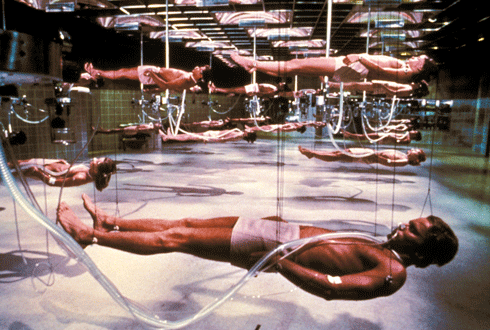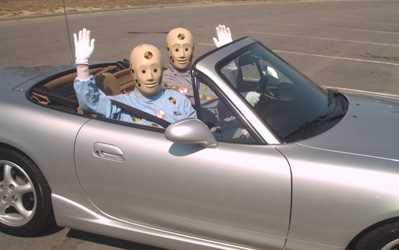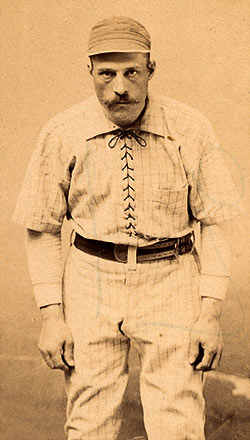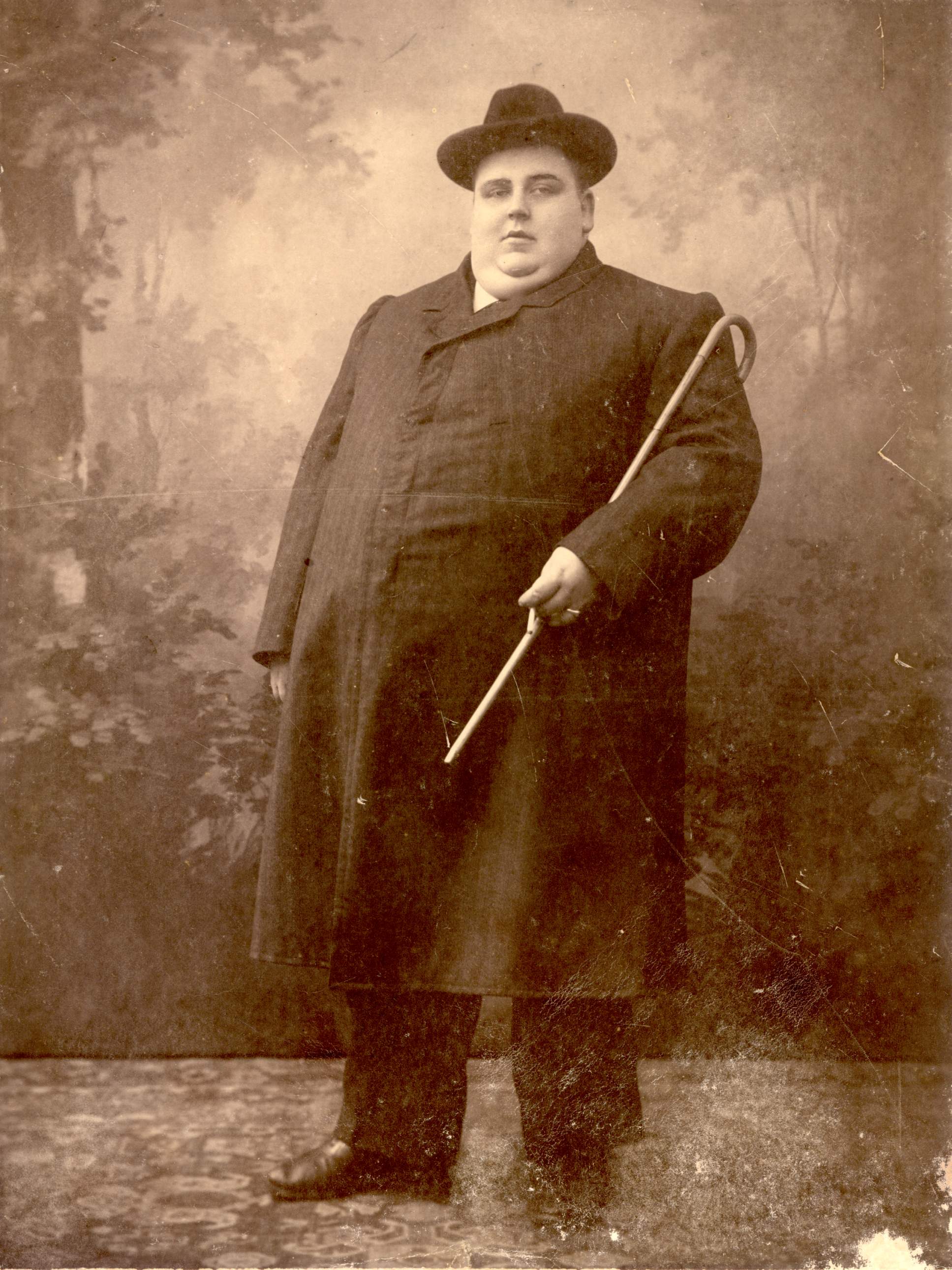Richard Feynman at Bell Labs, 1985.
You are currently browsing the yearly archive for 2012.
Tags: Richard Feynman
Norman Mailer, a towering talent prone to huge missteps, became the worst groom this side of William S. Burroughs in 1960 when he stabbed his wife. His punishment was 17 days in Bellevue for observation; a suspended sentence was subsequently arrived at. An excerpt from the initial November 22, 1960 New York Times report of the infamous incident:
“When detectives went to question his wife Sunday at the hospital, they were told she was too ill to be questioned. One wound was said to be near her heart.
Last night, the hospital permitted the police to question her. They said she admitted with reluctance that her husband had stabbed her.
She said the stabbing occurred about 5 A.M. Sunday at a party at their apartment.
Mrs. Mailer told the police she could give no reason for the stabbing.
She said her husband suddenly walked up to her, looked at her, stabbed her with what she thought was a penknife or clasp knife, and left the apartment.
Mrs. Mailer said her husband later took her to the hospital.”
Tags: Adele Mailer, Norman Mailer
You’ve probably seen this appearance by Louis C.K. with Conan (whom he wrote for earlier in his career) about a dozen times because it’s arguably the stand-up’s most famous moment. But I post it here anyway because I think when this interconnected and narcissistic age has calmed down, it will be the truest thing anyone has said about us. A compliment it’s not.
From “Do You Really Want to Live Forever?” Ronald Bailey’s Reason review of Stephen Cave’s new book, Immortality, which sees the defeat of death as a Pyrrhic victory:
“Why not simply repair the damage caused by aging, thus defeating physical death? This is the goal of transhumanists like theoretical biogerontologist Aubrey de Grey who has devised the Strategies for Engineered Negligible Senescence (SENS) program. SENS technologies would include genetic interventions to rejuvenate cells, stem cell transplants to replace aged organs and tissues, and nano-machines to patrol our bodies to prevent infections and kill nascent cancers. Ultimately, Cave cannot argue that these life-extension technologies will not work for individuals but suggests that they would produce problems like overpopulation and environmental collapse that would eventually subvert them. He also cites calculations done by a demographer that assuming aging and disease is defeated by biomedical technology accidents would still do in would-be immortals. The average life expectancy of medical immortals would be 5,775 years.” (Thanks Browser.)
Tags: Aubrey de Grey, Ronald Bailey, Stephen Cave
From a piece about the need for ethical robots, in the Economist:
“Robots are spreading in the civilian world, too, from the flight deck to the operating theatre. Passenger aircraft have long been able to land themselves. Driverless trains are commonplace. Volvo’s new V40 hatchback essentially drives itself in heavy traffic. It can brake when it senses an imminent collision, as can Ford’s B-Max minivan. Fully self-driving vehicles are being tested around the world. Google’s driverless cars have clocked up more than 250,000 miles in America, and Nevada has become the first state to regulate such trials on public roads. In Barcelona a few days ago, Volvo demonstrated a platoon of autonomous cars on a motorway.
As they become smarter and more widespread, autonomous machines are bound to end up making life-or-death decisions in unpredictable situations, thus assuming—or at least appearing to assume—moral agency. Weapons systems currently have human operators ‘in the loop,’ but as they grow more sophisticated, it will be possible to shift to ‘on the loop’ operation, with machines carrying out orders autonomously.
As that happens, they will be presented with ethical dilemmas. Should a drone fire on a house where a target is known to be hiding, which may also be sheltering civilians? Should a driverless car swerve to avoid pedestrians if that means hitting other vehicles or endangering its occupants? Should a robot involved in disaster recovery tell people the truth about what is happening if that risks causing a panic?”
••••••••••
Volvo’s autonomous vehicles in Barcelona:
In Evgeny Morozov’s new article at Slate, he explains why cyber warfare may not be attractive to terrorist groups. Of course, if there was a critical mass of driverless cars or robotic surgeons to tamper with, things might be different. There would definitely by a scary wow factor in that scenario. An excerpt:
“Terrorists may be more keen on anonymity, but the reality is that in the decade since 9/11, no terrorist group has had much success causing serious disruption of the civilian or military infrastructure. For a group like al-Qaida, the costs of getting it right are too high, particularly because it’s not guaranteed that such a cyber-terror campaign would be as spectacular as detonating a bomb in a busy public square.”
Tags: Evgeny Morozov
From the June 5, 1897 Brooklyn Daily Eagle:
“Eva Churchill, 3 years of age, a daughter of James Churchill, a Canarsie bayman, died yesterday afternoon at her house on Rockaway Avenue, near Avenue L, Canarsie Grove, from shock and convulsions caused by fright at the snoring of a drunken man.”
Tags: Eva Churchill, James Churchill
Tags: Buckminster Fuller
Kidney 4 Sale (Manhattan)
Young, healthy, non-smoker, athletic (jogger, tennis), educated (Bachelor of Science in Marketing), blood type A woman is looking to share my kidney with an individual/family who really needs it. I am not willing to travel outside of the continental US to have surgery. The job market has been unsympathetic to me and at this point its either sell a kidney or compromise my dignity. I would rather not compromise my dignity, besides, I would be helping to save someone’s life.
The opening of “Remember This,” Joshua Foer’s excellent 2007 National Geographic piece about people with extreme memories and those of us with more average neural connections governing the data and images we retain:
“There is a 41-year-old woman, an administrative assistant from California known in the medical literature only as ‘AJ,’ who remembers almost every day of her life since age 11. There is an 85-year-old man, a retired lab technician called ‘EP,’ who remembers only his most recent thought. She might have the best memory in the world. He could very well have the worst.
‘My memory flows like a movie—nonstop and uncontrollable,’ says AJ. She remembers that at 12:34 p.m. on Sunday, August 3, 1986, a young man she had a crush on called her on the telephone. She remembers what happened on Murphy Brown on December 12, 1988. And she remembers that on March 28, 1992, she had lunch with her father at the Beverly Hills Hotel. She remembers world events and trips to the grocery store, the weather and her emotions. Virtually every day is there. She’s not easily stumped.
There have been a handful of people over the years with uncommonly good memories. Kim Peek, the 56-year-old savant who inspired the movie Rain Man, is said to have memorized nearly 12,000 books (he reads a page in 8 to 10 seconds). ‘S,’ a Russian journalist studied for three decades by the Russian neuropsychologist Alexander Luria, could remember impossibly long strings of words, numbers, and nonsense syllables years after he’d first heard them. But AJ is unique. Her extraordinary memory is not for facts or figures, but for her own life. Indeed, her inexhaustible memory for autobiographical details is so unprecedented and so poorly understood that James McGaugh, Elizabeth Parker, and Larry Cahill, the neuroscientists at the University of California, Irvine who have been studying her for the past seven years, had to coin a new medical term to describe her condition: hyperthymestic syndrome.
EP is six-foot-two (1.9 meters), with perfectly parted white hair and unusually long ears. He’s personable, friendly, gracious. He laughs a lot. He seems at first like your average genial grandfather. But 15 years ago, the herpes simplex virus chewed its way through his brain, coring it like an apple. By the time the virus had run its course, two walnut-size chunks of brain matter in the medial temporal lobes had disappeared, and with them most of EP’s memory.”
••••••••••
Oliver Sacks discussing his pen pal Alexander Luria, the neuropsychologist who authored The Mind of a Mnemonist:
Tags: Alexander Luria, Joshua Foer, Oliver Sacks
Major League Baseball long generated most of its income through live attendance, so there was apprehension about “giving away” games on cable, even as screens shrunk and became ubiquitous. But regional–and very lucrative–contracts have proliferated as team owners realized that they weren’t harming their brands but extending them. And cable badly needs baseball, since it can provide so much live content that isn’t likely to be time-shifted. From the Sports Economist:
“Local TV rights provides the revenue stream, but doesn’t this just push back the insanity one level? Why would anyone bid these amounts for baseball — America’s dying pastime? A funny thing happened on the way to the funeral — baseball franchises discovered that a substitute was actually a complement. Over the past several years, teams switched to televising most, if not all, of their games via local broadcast/cable/satellite. Teams long resisted such TV saturation, thinking that televised games substitute for fans in the seats. Texas drew almost 3 million fans last season in spite of extensive regional televising of their games. Yes, a few fans, at the margin, will choose to attend fewer games and watch on TV. However, many potential fans will attend very few games regardless. Televising the games becomes a way of extending the stadium capacity to include these households. The TV advertisers along with cable/satellite fees pay for these ‘at-home season ticket holders.'”
From an L.A. Times piece about the C-1, a self-balancing, enclosed, electric motorcycle from Lit Motors.
“Lit Motors calls it the C-1, but the San Francisco start-up’s untippable motorcycle seems nothing short of magic. It uses gyroscopes to stay balanced in a straight line and in turns in which drivers can, in theory, roll down their windows and drag their knuckles on the ground.
Is it a motorcycle? A car? Neither. It’s an entirely new form of personal transportation, presuming it gets off the ground.
The all-electric vehicle is fully enclosed and uses a steering wheel and floor pedals like a car. But it weighs just 800 pounds and balances on two wheels even when stopped, making it more efficient than hauling around a 2-ton four-wheeler and safer than an accident-prone bike.”
From “How Headphones Changed the World,” Derek Thompson’s Atlantic article about the unusual origins of the tech item, which was invented by Nathaniel Baldwin, a Mormon supporter of the polygamist movement:
“In 1910, the Radio Division of the U.S. Navy received a freak letter from Salt Lake City written in purple ink on blue-and-pink paper. Whoever opened the envelope probably wasn’t expecting to read the next Thomas Edison. But the invention contained within represented the apotheosis of one of Edison’s more famous, and incomplete, discoveries: the creation of sound from electrical signals.
The author of the violet-ink note, an eccentric Utah tinkerer named Nathaniel Baldwin, made an astonishing claim that he had built in his kitchen a new kind of headset that could amplify sound. The military asked for a sound test. They were blown away. Naval radio officers clamored for the ‘comfortable, efficient headset’ on the brink of World War I. And so, the modern headphone was born.”
••••••••••
Headphones on display in a 1970s Continental ad:
Tags: Derek Thompson, Nathaniel Baldwin
Speaking of bugs, I’m sorry about how buggy the site’s been today. I’ve contacted the host about it, so I’m sure it will be fixed within 600 hours.
The first three graphs of Wil S. Hylton’s excellent New York Times Magazine article about Craig Venter, who wants to make tiny machines that breathe:
“In the menagerie of Craig Venter’s imagination, tiny bugs will save the world. They will be custom bugs, designer bugs — bugs that only Venter can create. He will mix them up in his private laboratory from bits and pieces of DNA, and then he will release them into the air and the water, into smokestacks and oil spills, hospitals and factories and your house.
Each of the bugs will have a mission. Some will be designed to devour things, like pollution. Others will generate food and fuel. There will be bugs to fight global warming, bugs to clean up toxic waste, bugs to manufacture medicine and diagnose disease, and they will all be driven to complete these tasks by the very fibers of their synthetic DNA.
Right now, Venter is thinking of a bug. He is thinking of a bug that could swim in a pond and soak up sunlight and urinate automotive fuel. He is thinking of a bug that could live in a factory and gobble exhaust and fart fresh air. He may not appear to be thinking about these things. He may not appear to be thinking at all. He may appear to be riding his German motorcycle through the California mountains, cutting the inside corners so close that his kneepads skim the pavement. This is how Venter thinks. He also enjoys thinking on the deck of his 95-foot sailboat, halfway across the Pacific Ocean in a gale, and while snorkeling naked in the Sargasso Sea surrounded by Portuguese men-of-war. When Venter was growing up in San Francisco, he would ride his bicycle to the airport and race passenger jets down the runway. As a Navy corpsman in Vietnam, he spent leisurely afternoons tootling up the coast in a dinghy, under a hail of enemy fire.” (Thanks Browser.)
Tags: Craig Venter, Wil S. Hylton
If you were going to be thrown into the clink in 1882, you could do a lot worse than the Butler Street Station House, where you were apparently given an unlimited number of pies to gorge yourself on. From an article in the January 27, 1882 Brooklyn Daily Eagle:
“‘Do you want something to write?’ asked Captain Leavey of a reporter, as he entered the Butler Street Station House this morning.
‘Yes,’ was the reply.
‘Well,’ said the captain, ‘we had a rare pair of lodgers here last night. They gave the names of John M. Clark and William Collins, and said they came from Hempstead. Before being shown upstairs one of them said to me: ‘Captain, we are awfully hungry; can’t you give us a bit of something to eat?’ They looked just the sort of fellows that could have relished some broiled crow, and so I said to them: ‘How hungry are you?’ The elder of the two smacked his lips and said he felt as though he could swallow a house and lot, so I sent around the corner to an adjoining bakery for some pie.
Half a dozen pies were set before them and they disappeared like snow before a blazing sun. Six more were produced and still they were not satisfied. I asked them if they intended to eat up the bakery, and the only reply received was to the effect that the people in Hempstead were all great eaters. So, I sent out for another half dozen, and they went the way of the rest in just as short a time. Then they said they had enough and retired for the night.
‘I tell you,’ said the captain, in conclusion, ‘I would not like to take a contract to feed the folks in Hempstead.'”
From “New York Has Some Prisons To Sell You,” Thomas Kaplan’s NYT article about the Governor Cuomo’s attempts to dismantle the state’s prison-industrial complex:
“These real-estate listings come from an unpracticed seller, the State of New York. After cutting costs through traditional means like freezing wages of state workers and consolidating government offices, Gov. Andrew M. Cuomo is embarking on a less conventional effort: trying to sell New York’s old prisons.
The state has a glut of vacant correctional facilities because of lower crime rates, new programs that allow early release for nonviolent offenders and the dismantling of its strict drug laws. The situation in New York reflects changing national attitudes toward criminal justice policy: the number of state prisoners nationwide declined in 2009 and 2010 for the first times in at least three decades, according to the federal Bureau of Justice Statistics.
Mr. Cuomo’s predecessor, Gov. David A. Paterson, closed three prisons as he confronted budget problems. Mr. Cuomo declared in his first address to the State Legislature that prisons were “not an employment program,” and proceeded to shut seven of the state’s remaining 67 correctional facilities, removing 3,800 beds.
These closings reflect a sharp reversal. After New York adopted mandatory drug sentences in 1973, the state’s prison population soared from 13,437 to a peak of 71,472 in 1999, prompting a boom in prison construction, much of it during the tenure of Gov. Mario M. Cuomo, the current governor’s father. But since then, the number of inmates in state facilities has fallen nearly a quarter, to about 55,000, leaving thousands of empty beds.”
Tags: Andrew Cuomo, Thomas Kaplan
A demonstration of Quantum Trapping–and its potential to revolutionize travel–at Tel Aviv University.

"Some of them love human dignity so much that they are ready to legalize torture to defend it." (Image by Ggia.)
The opening of Slavoj Žižek’s new essay about Greece in the London Review of Books, which articulates how we often sacrifice our principles during a fight to preserve those very same principles:
“Imagine a scene from a dystopian movie that depicts our society in the near future. Uniformed guards patrol half-empty downtown streets at night, on the prowl for immigrants, criminals and vagrants. Those they find are brutalised. What seems like a fanciful Hollywood image is a reality in today’s Greece. At night, black-shirted vigilantes from the Holocaust-denying ne0-fascist Golden Dawn movement – which won 7 per cent of the vote in the last round of elections, and had the support, it’s said, of 50 per cent of the Athenian police – have been patrolling the street and beating up all the immigrants they can find: Afghans, Pakistanis, Algerians. So this is how Europe is defended in the spring of 2012.
The trouble with defending European civilisation against the immigrant threat is that the ferocity of the defence is more of a threat to ‘civilisation’ than any number of Muslims. With friendly defenders like this, Europe needs no enemies. A hundred years ago, G.K. Chesterton articulated the deadlock in which critics of religion find themselves: ‘Men who begin to fight the Church for the sake of freedom and humanity end by flinging away freedom and humanity if only they may fight the Church … The secularists have not wrecked divine things; but the secularists have wrecked secular things, if that is any comfort to them.’ Many liberal warriors are so eager to fight anti-democratic fundamentalism that they end up dispensing with freedom and democracy if only they may fight terror. If the ‘terrorists’ are ready to wreck this world for love of another, our warriors against terror are ready to wreck democracy out of hatred for the Muslim other. Some of them love human dignity so much that they are ready to legalise torture to defend it. It’s an inversion of the process by which fanatical defenders of religion start out by attacking contemporary secular culture and end up sacrificing their own religious credentials in their eagerness to eradicate the aspects of secularism they hate.” (Thanks Browser.)
Tags: Slavoj Žižek
From an essay by Gabrielle Esperdy at Design Observer about the Trollope-ish trips across America taken by the late urban theorist Reyner Banham, who loved Los Angeles:
“Once Banham got a driver’s license, the pull of those miles was irresistible, and he spent plenty of time behind the wheel: up and down the California coast, into the deserts and canyons of the Southwest and Texas, across the rust belt and the Midwest, and over and through the northeast megalopolis. There were countless stops in between and along the way, all fully documented in field notebooks, maps, postcards and 35mm slides. Banham visited architectural monuments and natural landmarks, evincing equal interest in the Seagram Building and the Cima Dome. He was attracted to everyday landscapes and out-of-the-way obscurities, supermarkets and motel chains having nearly the same allure as one-off wilderness resorts. He explored thriving commercial centers and abandoned industrial wastelands (and vice versa), lavishing the same attention on a Ponderosa Steak House as on a General Mills grain elevator.
From the Tennessee Valley to Silicon Valley, no building or landscape was unworthy — or safe — from Banham’s formal analysis, socio-cultural critique or outspoken opinionating. He thought the TVA dams with their ‘overwhelming physical grandeur’ were better in real life than in the iconographic New Deal photographs where he had first encountered them, and while he may have sneered at the ‘Redneck Macholand’ in which they were located, he reserved his true scorn for the ‘eco-radicalist’ supporters of the Endangered Species Act who, in the 1970s, prevented the closing of the Tellico Dam sluices in order to preserve the snail darter minnow. The construction of the dam may have looked more arrogant, but Banham wondered if it really was.
The ‘Fertile Crescent of Electronics’ presented no such moral quandaries when Banham visited the sylvan corporate landscapes of IBM, Hewlett-Packard and other now obsolete tech-companies in 1981. Concerns about the environmental impact of all those microchips were still about a decade away and, given his long-standing technophilia, Banham would probably have minimized their significance with the same greater-good rationale he applied to the TVA. While 1981 was early enough in the digital revolution that Space Invaders was cutting edge, it was late enough that Silicon Valley had already produced a ‘better-than-respectable body of architecture.’ The buildings, in Banham’s view, were as sleek, silver and modern as the gadgets designed in the research labs within, an alignment of high-tech imagery and confident industrial consciousness — exemplified by MBT Associate’s IBM’s Santa Teresa campus in San Jose — that Banham considered a cause for celebration. Only the most ‘crass and unobservant’ among the ‘modern-architecture knockers’ and ‘California-mockers’ could possibly disagree.”
Tags: Gabrielle Esperdy, Reyner Banham
Brief 1977 film about laserists and their craft. Dude.
From “The Night the Lights Went Out in Griffith Park,” an L.A. Times article about the first laser-light show for the masses, in 1973: “Before the lights go down, the creator of Laserium, Ivan Dryer, is introduced and receives a lengthy standing ovation. The 62-year-old filmmaker with an astronomy and engineering background saw his first ‘laser light show’ in November 1970, when he was invited to film a demonstration by a Caltech scientist who’d been using a laser in her off hours to create artwork. A month later, he approached officials at the Griffith Park Observatory, where he’d once worked as a guide, with the idea of putting on a show there. For three years, the answer was no, but a new administration warmed to the idea, and Laserium was born.
‘When we first started, there were a whole lot of mistakes to be made,’ recalls Dryer, a tall, wizened, Ichabod Crane of a man. ‘We found that if we made mistakes on cue, on the beat, that was OK with the audience.’There was ‘The John Effect’–if too many toilets were flushed in the bathroom, the water pressure in the water-cooled ion gas laser (which reaches a core temperature of 5,000 degrees) would fail. Dryer also recounts the time his then-partner accidentally touched a high-voltage wire and shocked himself during a show, the audience believing the screaming was part of the entertainment. Similarly, when a fly landed on the lumia lens and began crawling around it, casting a giant sci-fi insect form on the ceiling, the crowd cheered wildly at the clever effect. Rather than swat it away, Dryer says, ‘we wished we could train it and hire it for future shows.’
In the intervening 28 years, laser technology and techniques improved, glitches were removed and new versions came along–Laser Rock, Pink Floyd’s Dark Side of the Moon, Led Zeppelin, Lollapalaser and the final incarnation, Laser Visions, which features ambient/ techno/electronica a la Orb, Enya and Vangelis.”
Tags: Ivan Drye
This post is the final reminder about tonight’s publication party for Jay Ruttenberg’s excellent humor compilation, The Lowbrow Reader Reader, at 7pm at the Housing Works Bookstore in Manhattan. (See details and directions.) There will be great entertainment by Wyatt Cenac of the Daily Show with Jon Stewart, singer-songwriter Adam Green of Moldy Peaches fame, wonderful teen music group Supercute!, and, God willling, a special appearance by the legendary 97-year-old comedian Professor Irwin Corey.
If you could show up, it would really help lift Jay’s sagging spirits. A lot of you don’t know about this, but Jay has been very depressed since late March, when he was punched in the vagina by a hobo. I don’t mean a homeless person who deserves our concern and help, but the kind of archetypal hobo who travels by boxcar and carries his belongings in a bindle and punches men in their vaginas. Let Jay know that you care about his aching ladyparts.
Thanks!
Tags: Adam Green, Fresno Slim, Jay Ruttenberg, Professor Irwin Corey, Supercute!, Wyatt Cenac
























